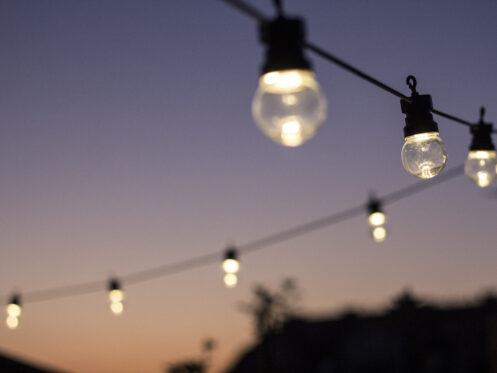The two main types of light bulbs that people consider for their home lighting needs are LED and incandescent. Ever since LED bulbs were made widely available to the public, there has been a lot of debate over whether they’re superior to traditional incandescent light bulbs. Here is everything you need to know about the pros and cons of LED and incandescent light bulbs to help you make an informed decision on which to use in your home.
What Are Incandescent Light Bulbs?
Incandescent light bulbs have been extremely popular for indoor and outdoor lighting for over 150 years. These bulbs produce light by running an electric charge across a metal filament. The heat that travels along the filament causes the metal to shine brightly.
A glass covering is used to protect the filament. The glass dome creates a vacuum effect within the bulb. Without the protection of the glass, the oxygen from outside would reach the filament and cause it to overheat almost immediately.
What Are LED Bulbs?
Light-emitting diodes or LED bulbs were invented in 1962. Instead of creating light from heat, LEDs utilize a semiconductor. When electricity passes through the semiconductor via the diode, it emits light. In the past 20 years, LED bulbs have become an incredibly popular choice for lighting in homes, commercial buildings, vehicles, and more.
Pros of Incandescent Light Bulbs
Despite LED bulbs exploding in popularity in recent years, many people still prefer incandescent light bulbs for various reasons.
Low Cost
The average incandescent light bulb is significantly cheaper than LED bulbs. Companies have had many years to craft designs and select materials for incandescent bulbs that both work well and are cost-effective.
Dimmable
Most incandescent light bulbs are easily able to be dimmed. Simply install any dimmer switch and control the level of brightness as much as you want. You have to buy special bulbs with specific drivers to achieve a dimming effect with LEDs. Additionally, you need to have special dimmer switches installed to make an LED dimmer work.
Warmer Color
There is a gentle warm color to incandescent lights that make the rooms in your home feel cozy and natural. LED bulbs most commonly have a bluish tint that makes any room appear cold and artificial.
Pros of LED Bulbs
Incandescent light bulbs are still a popular option for many lighting applications. However, there are numerous reasons why LED bulbs have skyrocketed in popularity.
Highly Energy-Efficient
One of the most appealing benefits of using LED bulbs over incandescent lights is their high energy efficiency. Incandescent lights waste a lot of electrical energy creating heat instead of light. LED bulbs utilize around 80% of the electricity they draw to create light and about 20% creates heat. In comparison, incandescent lights waste around 90% or more generating heat and 10% or less to create visible light.
Additionally, LED bulbs require much less wattage to create the same amount of light as incandescent bulbs. On average, for every 60 watts an incandescent bulb uses, it usually takes six to 10 watts for an LED to achieve the same level of illumination. Reducing energy usage and waste saves you money and helps the environment.
Long Lifespan
LED bulbs last much longer than any other type of bulb on the market. An LED bulb lasts around 50,000 hours of use on average, but some higher-end models can last 100,000 hours. In addition to saving you from the annoyance of having to frequently buy light bulbs, the longer lifespan of LED bulbs also helps prevent waste.
Flexibility
LED bulbs have a much wider range of use than other types of light bulbs. They can easily be made into strips for decorative lighting in tight spots such as behind your TV or around your windows. LED bulbs come in a variety of colors that add unique accents to the rooms of your home. You can even easily install battery-powered LEDs to illuminate small areas like closets or pantries.
Cons of Incandescent Light Bulbs
Incandescent light bulbs have their benefits, but there are also several disadvantages to using them instead of LEDs.
Fragility
Incandescent bulbs break very easily. Even if you don’t break the glass, the filament inside is extremely fragile and easily broken after some light bumps or shaking. Incandescent bulbs are so fragile that they are known to break while simply trying to unscrew them from a socket. Getting a broken light bulb out of a socket may result in cuts and electrocution. However, it’s not an uncommon problem for people who regularly rely on incandescent bulbs.
Short Lifespan
In comparison with the impressive 50,000 to 100,000-hour lifespan of LED bulbs, incandescent bulbs last only a fraction of the time. On average, incandescent light bulbs last around 1,000 to 2,000 hours of usage.
Poor Energy Efficiency
Incandescent bulbs are so inefficient that efforts to ban them from sale in the United States have gained a lot of traction. Certain incandescent bulbs will likely remain available to be used in items like heat lamps. However, incandescent lighting may be phased out entirely in the near future.
Cons of LED Bulbs
There are many reasons why people love LED bulbs, but they also come with some drawbacks.
Higher Cost
A common cause of people steering away from LED bulbs at the store is the price tag. LED bulbs are significantly more expensive than other types of light bulbs. However, their initial prices have been dropping over the years as they become more commonly produced and used. Additionally, the higher cost of bulbs can easily be offset by the energy savings you’ll enjoy.
Difficult to Dim
Areas like your kitchen, bedroom, and dining room benefit from having dimmable lights. However, LED bulbs are much more difficult to make dimmable than incandescent lights.
Blue Light May Cause Sleep Issues
If you use plain LED bulbs in your bedroom, you may notice that you have more difficulty sleeping. The bluish tint of plain LED bulbs tricks your body into thinking it’s still daytime. Exposure to the blue light throws off your circadian rhythm by suppressing the production of melatonin. The warm orange tint of incandescent bulbs has barely any effect on your circadian rhythm. That’s why your computer, phone, and tablet have the option to shift from a blue-tinted screen to orange in the evening hours.
Certain types of LED lighting fixtures can now shift from a cooler blue to a warmer orange or yellow color. However, they’re more expensive than default blue LED bulbs.
No matter if you prefer LED or incandescent bulbs in your home, you can rely on our skilled technicians at Thermo Direct to help you with all of your lighting needs. In addition to lighting, we also provide repair and installation services for heaters, air conditioners, ceiling fans, surge protectors, generators, air ducts, gas lines, and much more. For additional information on any of the services we provide to the areas in and around Raleigh, North Carolina, contact us at Thermo Direct today.







